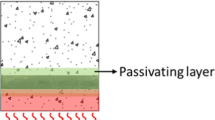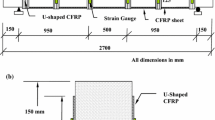Abstract
In many cases the corrosion of steel reinforcement is considered to be the main reason that leads to the deterioration of the bond between steel reinforcement and concrete and causes the failure of members. However, stirrups with smaller diameter are more likely to get rusted and it is more difficult to find corrosion expansion cracks on the surface of concrete. Then the function of stirrups to restrict longitudinal bar from slipping will be weakened, which alters the mechanical properties and failure mode of corroded Reinforced Concrete (RC) beams. In this paper, the influence of corrosion of stirrups and the effect of strengthening corroded RC beams with Carbon Fiber Reinforced Polymer (CFRP) sheets were studied. The corrosion rate for each group varied between 0% to 18% which represented mass loss of the longitudinal steel reinforcement on the tension side. The longitudinal reinforcement of beams in Group A was not wrapped by the stirrups in order to simulate the situation that the stirrups were seriously corroded and lost their function. Beams of Group B were corroded control beams. Beams of Group C were corroded and then repaired by applying longitudinal CFRP sheets at the bottom and additional U-shaped CFRP sheets around the cross-section. Test results showed that the corrosion of stirrups had a detrimental effect on strength as well as the bond stress between steel bars and concrete. The mechanical mode of experimental beams tended to act like an arch. The greater the corrosion rate was, the more obvious the arch effect was. In addition, combining longitudinal and U-shaped CFRP sheets enhanced the ultimate load by an average of 56.5% of corroded RC beams. However, because of the longitudinal cracks, the strengthening effect of CFRP was much diminished when the corrosion rate was particularly high.
Similar content being viewed by others

References
Al-Hammoud, R., Soudki, K., and Topper, T. H. (2010). “Bond analysis of corroded reinforced concrete beams under monotonic and fatigue loads.” Cement and Concrete Composites, Vol. 32, No. 3, 194–203, DOI: 10.1016/j.cemconcomp.2009.12.001.
Al-Rousan, R. Z. and Issa, M. A. (2017). “Flexural behavior of RC beams externally strengthened with CFRP composites exposed to severe environment conditions.” KSCE Journal of Civil Engineering, Vol. 21, No. 6, 2300–2309, DOI: 10.1007/s12205-016-0570-x.
Al-Saidy, A. H., Al-Harthy, A. S., Al-Jabri, K. S., Abdul-Halim, M., and Al-Shidi, N. M. (2010). “Structural performance of corroded RC beams repaired with CFRP sheets.” Composite Structures, Vol. 92, No. 8, 1931–1938, DOI: 10/1016/j.compstruct.2010.01.001.
Al-Saidy, A. H., Saadatmanesh, H., and El-Gamal S. (2016). “Structural behavior of corroded RC beams with/without stirrups repaired with CFRP sheets.” Materials and Structures, Vol. 49, No. 9, pp 3733–3747, DOI: 10.1617/s11527-015-0751-y.
Azam, R. and Soudki, K. (2012). “Structural performance of shearcritical RC deep beams with corroded longitudinal steel reinforcement.” Cement and Concrete Composites, Vol. 34, No. 8, 946–957, DOI: 10.1016/j.cemconcomp.2012.05.003.
Badawi, M. and Soudki, K. (2010). “CFRP Repair of RC beams with shear-span and full-span corrosions.” Journal of Composites for Construction, Vol. 14, No. 3, 323–335, DOI: 10.1061/(ASCE) CC.1943-5614.0000065.
Barros, A. O., Rezazadeh, M., and Laranjeira, P. S. (2017). “Simultaneous flexural and punching strengthening of RC slabs according to a new hybrid technique using U-shape CFRP laminates.” Composite Structures, Vol. 159, 600–614, DOI: 10.1016/j.compstruct.2016.10.009.
Chin, S. C., Shafiq, N., and Nuruddin, M. F. (2015). “FRP as strengthening material for Reinforced Concrete beams with openings - A review.” KSCE Journal of Civil Engineering, Vol. 19, No. 1, 213–219, DOI: 10.1007/s12205-011-0162-8.
Coronelli, D. and Gambarova, P. (2004). “Structural assessment of corroded reinforced concrete beams: Modeling guidelines.” Journal of Structural Engineering, Vol. 130, No. 8, 1214–1224, DOI: 10.1061/(ASCE)0733-9445(2004).30:8(1214).
Davis, M., Hoult, N. A., and Scott, A. (2016). “Distributed strain sensing to determine the impact of corrosion on bond performance in reinforced concrete.” Construction and Building Materials, Vol. 114, 481–491, DOI: 10.1016/j.conbuildmat.2016.03.205.
Dong, W., Murakami, Y., Oshita, H., Suzuki, S., and Tsutsumi, T. (2011). “Influence of both stirrup spacing and anchorage performance on residual strength of corroded RC beams.” Journal of Advanced Concrete Technology, Vol. 9, No. 3, 261–275, DOI: 10.3151/jact.9.261.
El-Maaddawy, T. and Chekfeh, Y. (2013). “Shear strengthening of Tbeams with corroded stirrups using composites.” ACI Structural Journal, Vol. 110, No. 5, 779–789.
Feng, Q., Visintin, P., and Oehlers, D. J. (2016). “Deterioration of bondslip due to corrosion of steel reinforcement in reinforced concrete.” Magazine of Concrete Research, Vol. 68, No. 5, 768–781, DOI: 10.1680/jmacr.15.00217.
Kreit, A., Al-Mahmoud, F., and Castel A. (2014). “Repairing corroded RC beam with near-surface mounted CFRP rods.” Materials and Structures, Vol. 44, No. 5, 1205–1217, DOI: 10.1617/s11527-008-9460-0.
Li, H., Wu, J., and Wang, Z. (2016). “Shear performance of reinforced concrete beams with corroded stirrups strengthened with carbon fiberreinforced polymer.” ACI Structural Journal, Vol. 113, No. 1, 51–61.
Schnerch, D., Dawood, M., Rizkalla, S., Sumner, E., and Stanford, K. (2006). “Bond behavior of CFRP strengthened steel structures.” Advances in Structural Engineering, Vol. 9, No. 6, 805–817, DOI: 10.1260/136943306779369464.
Soudki, K. and Sherwood, T. (2003). “Bond behavior of corroded steel reinforcement in concrete wrapped with carbon fiber reinforced polymer sheets.” Journal of Materials in Civil Engineering, Vol. 15, No. 4, 358–370, DOI: 10.1061/(ASCE)0899-1561(2003).5:4(358).
Wang, L., Yi, J., Xia, H., and Fan, L. (2016). “Experimental study of a pull-out test of corroded steel and concrete using the acoustic emission monitoring method.” Construction and Building Materials, Vol. 122, 163–170, DOI: 10.1016/j.conbuildmat.2016.06.046.
Wang, L., Zhang, X., and Zhong, L. H. (2017). “Analysis of mechanical properties and arch effect of corroded reinforced concrete Beams.” Journal of Huaqiao University, Vol. 38, No. 1, 24–30. (in Chinese).
Wu, Q. and Yuan, Y. S. (2008). “Experimental study on the deterioration of mechanical properties of corroded steel bars.” China Civil Engineering Journal, Vol. 41, No. 12, 42–47. (in Chinese)
Xia, J., Jin, W. L., and Li, L. Y. (2011). “Shear performance of reinforced concrete beams with corroded stirrups in chloride environment.” Corrosion Science, Vol. 53, No. 5, 1794–1805, DOI: 10.1016/j.corsci.2011.01.058.
Xue, X., Seki, H., and Song, Y. (2014). “Shear behavior of RCbeams containing corroded stirrups.” Advances in Structural Engineering, Vol. 17, No. 2, 165–177, DOI: 10.1260/1369-4332.17.2.165.
Zhou, H. J., Lu, J. L., Xv, X., Dong, B. Q., and Xing, F. (2015). “Effects of stirrup corrosion on bond-slip performance of reinforcing steel in concrete: An experimental study.” Construction and Building Materials, Vol. 93, 257–266, DOI: 10.1016/j.conbuildmat.2015.05.122.
Zeng, Y. (2014). “Study on degradation of bond properties of corroded reinforced concrete and its influence to the flexural stiffness of beam.” PhD Thesis, Chongqin University, CN. (in Chinese)
Zeng, Y. H., Gu, X. L., and Zhang, W.P. (2009). “Accelerated corrosion technique for reinforcement steel bars in concrete.” Structural Engineers, Vol. 25, No. 1, 101–105. (in Chinese)
Author information
Authors and Affiliations
Corresponding author
Rights and permissions
About this article
Cite this article
Chen, S., Lyu, H., Wang, L. et al. Research on Arch Effect and CFRP Strengthening Effect of RC Beams with Corroded Stirrups. KSCE J Civ Eng 22, 5026–5034 (2018). https://doi.org/10.1007/s12205-017-1236-z
Received:
Revised:
Accepted:
Published:
Issue Date:
DOI: https://doi.org/10.1007/s12205-017-1236-z



